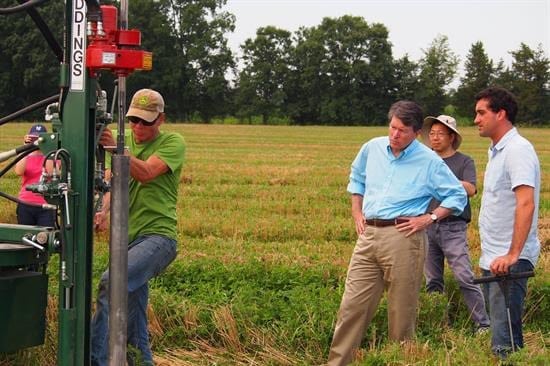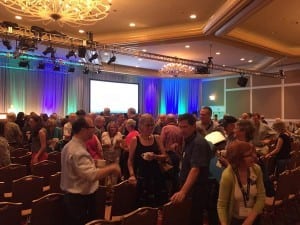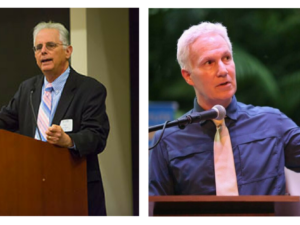
CCL volunteers hosted a site visit for Congressman John Faso (R-NY) at Stone House Farm in Hudson, NY. Read about it here.
Hosting effective site visits with your member of Congress
By Stephanie Sides
When we join CCL as volunteers, we quickly learn about the organization’s focus: getting climate fee and dividend (CF&D) legislation passed in Congress. To establish relationships with our members of Congress (MoCs) and to lay the groundwork for a pitch for their support on this issue, we meet with them at their district offices and in Washington, D.C., through CCL’s annual lobbying efforts.
Two webinars presented last month by Citizens’ Climate University (CCU) discussed a complementary strategy to build these relationships: organizing effective in-district site visits to encourage MoC commitment to CF&D legislation. The webinars showcased case studies of events in Michigan and Utah (described in an upcoming blog post) and best practices for how to plan these events (described here).
Such visits are like field trips: The MoC gets out of his or her office somewhere “in the field” to talk with constituents one on one about what’s important to them. These events connect the MoC with constituents’ values and can be used to demonstrate growing political will in the district. The most effective visits are those that affect all the senses, where the MoC can touch and feel things, or hear personal stories. Because they provide a more tangible and specific backdrop to the CF&D “ask,” the MoC is more likely to be receptive.
Bradford Fitch, President and CEO of the Congressional Management Foundation and author of “Citizens’ Handbook to Influencing Elected Officials,” says that, based on his organization’s research, “members of Congress consider visits to local facilities, more than any other source of information, to be the most valuable way to understand constituent views and opinions.” For citizens, such visits are among the most effective ways they can interact with their MoCs, build relationships with them, and influence them. Fitch’s CCU presentation includes this comprehensive planning checklist.
These events might showcase the specific impact of climate change, such as the effect of sea-level rise on Florida’s coastal communities or the deterioration of skiing conditions in Utah. The events could also showcase how citizens are helping solve the climate crisis, by showing people building or using renewable energy or farmers extracting and storing carbon.
Here’s a brief overview of the process Fitch outlines:
- Begin planning at least 5-6 weeks out, focusing on the big picture: What message do you want to convey? Then reverse engineer the sequence of steps necessary to ensure the event has the intended impact. Put yourself in the MoC’s shoes: Think about how the event can promote the MoC’s goals or pique his or her interest to attend.
- Visualize what event photos will look like. Average-looking people and those in uniform photographed casually with smartphones work better than “guys in ties” photographed professionally.
- Identify the process within the MoC’s office to schedule the event. You may need to download a form, enter data in an interactive web form, fax a hard copy form, fax a request on letterhead, etc. Call your district office to determine the preferred process.
- Keep the Congressional calendar in mind (Google “congressional calendar” to find the current one). It has 12-13 recesses per year, which you will want to take advantage of for a site visit.
- Be flexible about the date and time of the event.
- Identify the process within your CCL chapter. Who owns the success of the event? Fitch suggests a “subcommittee of two” so there’s a second point of view and responsibility can be shared due to illness or a family emergency at the last minute. What knowledge, skill sets, and relationships can you draw on from members participating in the planning? As planning tasks become clearer, who will take responsibility for each? Assign deadlines by creating a calendar of what needs to be done by whom and when.
- Do homework on the MoC. What’s his or her position on climate change? Has he or she made any speeches on the topic? For MoCs that are resistant, a useful approach to the district office is to say: “I understand the MoC has made some tough statements on climate. Might he or she might be interested in hearing about x?”
- Draft the ask in writing. This step is worth 50% of whether the ask is accepted. Include clear logistics (who’s involved, specific names), paint a picture (the nature of the location and sequence of events), include contact information (two people with emails and cell phone numbers), and show the impact of climate change in the district. CCL volunteers may have relationships, say with a mayor or leading businessperson, that can be leveraged. If such people can be enticed to participate, the MoC will be more likely to say yes. But limit the number of luminaries and make sure no one outranks (or even equals in rank) the MoC. If normally competing organizations plan to participate, that will pique the MoC’s attention: Why are they working together?
- Follow up. Be persistent. Thousands of communications come through a district office, so your request may fall through the cracks. Find out how quickly the office typically takes to respond to a request for a meeting with the MoC. After two weeks, district offices mostly (43%) will have responded. If you reach week four without response, it’s okay to follow up: Call the district office and say something like this, “I sent a request. I think I did it right. Can you please check on it?”
Stay tuned for my next blog about how Michigan and Utah used this methodology in planning successful site visits.
Every week, Citizens’ Climate University hosts a live, online learning session to educate and empower climate action volunteers. Browse past lessons in CCL Community, and mark your calendar for upcoming sessions.





